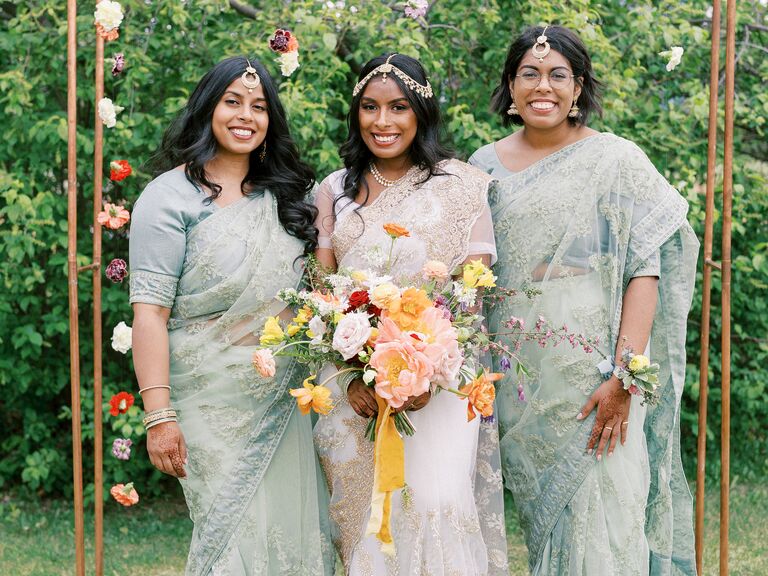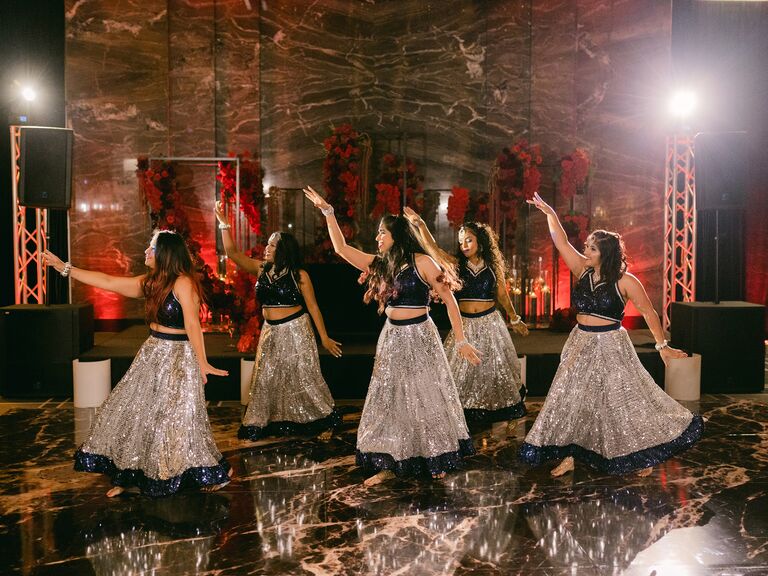Everything You Need to Know About Being an Indian Wedding Bridesmaid
A wedding is an incredible chance to learn about and participate in a new-to-you culture, especially if you have been invited to be an Indian wedding bridesmaid. From the rich ceremonies helping the soon-to-be-wed couple prepare for and celebrate their wedding week to the spunky dance numbers an Indian bridal party gets to perform, there is no shortage of new experiences, charming traditions and jaw-dropping beauty to see at most Indian weddings.
While a bridal party has a myriad of responsibilities at any wedding, the bridesmaid duties at an Indian wedding are a bit different due to the additional ceremonies and parties involved. But, we've pulled in wedding experts Sneh Diwan of Diwan by Design and Ivy from Ivy Weddings to help walk you through everything you need to know when preparing for such a role.
In this story:
- What Do Bridesmaids Wear at Indian Weddings?
- Candle Bouquets for Bridesmaids at an Indian Wedding
- Bridesmaid Entrance at an Indian Wedding
- Bridesmaid Dance at an Indian Wedding
- Indian Wedding Bridesmaid Duties
What Do Bridesmaids Wear at Indian Weddings?
Unlike a typical American wedding and reception that often lasts just a few hours, most Indian weddings are multi-day events. With this, bridesmaids will likely have to bring a variety of outfits for all the different parties taking place during the celebration. Brides will usually provide guidance on the coordinating attire worn at the ceremony, whether that is a matching ensemble worn by each person or differing dresses, lehengas, or sarees complimenting each individual's style.
However, bridesmaids will likely have to pick out their own outfits for the rest of the festivities. Indian weddings are full of color and spunk and they are a perfect opportunity to be a little bolder with your clothing choices. Most experts warn to stay away from black and red, as the former is simply not a celebratory color proper for a wedding and the latter is often worn by the bride.
For bridesmaids, while you can choose a Western-style dress for the pre- or post-wedding activities, traditional Indian culture invites guests to get the full experience, which includes donning a lehenga or saree. Lehengas come in two pieces, typically a cropped top and a full skirt. A saree is a long wrap that encompasses the body, often made of silk and is preferred by families from western and southern India. Choosing these outfits is often the greatest cost associated with being an Indian wedding bridesmaid, as each outfit can run between $100 and $800.
Popular color options are jewel tones, like emerald green, especially for evening events, although these weddings are excellent spots to wear bright colors like hot pink, rich blue or even royal purple. If you're not quite ready to don such a bold outfit, though, pastel colors are welcomed too, especially during daytime events. Accessorizing with bracelets like bangles and necklaces is key to pulling the traditional look together. Lastly, make sure whatever you pick is comfortable for dancing, as there is no shortage of opportunities to move your body at most Indian weddings!
Candle Bouquets for Bridesmaids at an Indian Wedding
Some brides choose to have their bridesmaids hold candle bouquets or lanterns instead of flowers during the ceremony. These often provide a soft, romantic aspect to the ceremony and are often less expensive than floral arrangements. In addition, they can be used as decorations during the reception and easily taken home as a keepsake to remember the event.
Bridesmaid Entrance at an Indian Wedding
While the bride often enters with her brothers, uncle, or other male relatives carrying a veil above her head, an Indian bride may also be hoisted off the ground on a small carriage. However, many brides have been switching up this entrance, especially if their ceremony is including different cultures, by having their bridesmaids escort them down the aisle to the Mandap.
If the bridesmaids arrive before the bride, it is important to show excitement and reverence for the ceremony that will soon begin. Sneh Diwan, founder and creative director at Diwan by Design, shared a few of her favorite song options for a romantic entrance: O Re Piya, Raataan Lambiyan, Jag Ghoomeya and Sun Saathiya.
At the reception, it will be time to dance to upbeat music, often with a choreographed dance. This is often chosen by the bride and could be from any genre, whether Indian, American pop or a fusion of both. Diwan's most recommended songs for the bridesmaids to enter the reception are Sauda Khara Khara, Garmi, Naagin or Makhna.
Bridesmaid Dance at an Indian Wedding
While it may sound intimidating, especially to bridesmaids participating in an Indian wedding for the first time, you will probably be responsible for dancing at least one choreographed number at the wedding week festivities.
To have it go off without a hitch, Sneh Diwan recommends having a video of the routine at least three months before the event, even before everyone has practiced together. This will allow dancers to have something "to refer back to when practicing on their own." She also recommends keeping "things simple in order to make the dance look cleaner and sharper."
While these bridal party dances sometimes take place at the reception, it is also common for the bridesmaids to dance during the sangeet or raas-garba the night before the wedding. This routine often has a Bollywood vibe and is an incredible opportunity to share in the joy, excitement and fun at an Indian wedding. Remember, these dance numbers are a way to experience the culture of the bride and groom, so lean in and enjoy the moment by leaving your nerves at the door.
Indian Wedding Bridesmaid Duties
For the best overview of all the bridesmaid duties at an Indian wedding, we spoke with Ivy, the photographer and founder of Ivy Weddings. From preparing a dance number to keeping the bride fed and watered, there are plenty of things to keep you busy during the wedding week.
Take Off Work
This may sound like a no-brainer at first, but Ivy urges anyone involved in an Indian wedding to double-check how many days to take off work, as these events often last for multiple days. She notes that "it is not uncommon for wedding events to start on a Tuesday and run through Saturday or Sunday, so find out which events you will need to attend from start to the big finale."
Plan Your Wardrobe
While the bride will likely provide direction for your wedding ceremony outfit, there will be many different opportunities to show off your style over the course of the week. Ivy shared with us that "bridesmaids typically pick their own fancy lehenga or a formal evening gown to change into for the evening reception. When picking your own outfits for the events, it's best to avoid black, or red (since the bride may choose red), but all other colors are fully welcome and celebrated!"
Support the Bride
Regardless of the culture surrounding the wedding, an essential duty of a bridesmaid is to support the bride-to-be in any way they can. Having lots of experience working and photographing Indian wedding festivities, Ivy points out that "as the wedding week goes on, remember that no matter how tired you are, the bride is experiencing everything you feel plus so much more - and has been awake much longer. If you're tired and hungry, check on the bride first to ask if you can bring her something, be mindful of when she last ate or drank and provide her with snacks and refreshments… and then do this again the next day and the next day and the next until the wedding is done. Taking care of the bride and checking on her throughout the wedding week is a pivotal duty of an Indian bridesmaid."



Ivy also points out that there is sometimes "more than a three-hour gap between the end of the ceremony and the start of the reception, (which means) you may be able to squeeze in a quick nap." If you do this, though, "make sure to set an alarm in time to help the bride with anything she may need."
Be the Point of Contact for Others
Even with the months of planning that go into a wedding, there are always last-minute details to be organized. As a bridesmaid, you can help make these small things fall into place without a hitch. Ivy says that "it's a good idea to get the contact information for the wedding planner, the groomsmen, the best man, siblings of the bride, or anyone you may need to be in contact with on the wedding week to help things run more smoothly, or track down missing items or details for the bride or groom, their parents, or the wedding photographer. Being available to the bride's family and helpful to vendors or guests is a great way to help lower the stress for the bride and keep any pressing issues away from her concern."
Stick to the Schedule
With all the dancing, partying and support you will be doing as a bridesmaid in an Indian wedding, you will certainly be tired at various points during the festivities. However, Ivy emphasizes how important it is to ensure you are on time for events throughout the week.
She wisely recommends that "if this is your first experience as a bridesmaid in an Indian wedding, you may have danced your heart out and had lots of fun the night before the wedding at the Sangeet (it is a party after all!), but the bride still has to be awake before the sun on the wedding day. It isn't uncommon for the sangeet dance floor to be open until almost midnight, while the bride is typically awake by 3AM, or before the sun is even close to rising, the next morning to start hair and makeup for the wedding ceremony. Whether it's the henna artist, the makeup artist, the saree draper, or the photographer, these vendors are booked for windows of time that are very tightly coordinated across all of the wedding party, family members, or logistics of the many events. Being on time to all the events and following the plans as closely as you can is paramount and will not only reduce stress but also help you experience every part of the magic that is an Indian wedding."
Practice, Practice, Practice!
Dance is a central part of Indian culture and the family will be overjoyed to see the bride's friends joining in this joyous activity. To reduce nerves and boost your confidence when dancing in front of the crowd, Ivy recommends that you "connect with the other bridesmaids to learn the music and details and to finalize your dance performance choreography. Second, prepare yourself to feel and enjoy the music! Dancing at an Indian wedding doesn't require years of experience, but does need an enthusiastic heart and a willingness to learn. For more dance tips, you can also find Indian dance tutorials online, watch Bollywood music videos, check Youtube for inspiration, or even follow some of the popular Indian wedding DJ's and music artists on social media for a weekly dose of music and dance inspiration."
Familiarize Yourself With the Various Ceremonies and Expectations
There are many traditions in an Indian wedding that the close friends and family of a bride will likely be invited to. Like most weddings, there will probably be a bridal shower or bachelorette party before the wedding. While this could take place the week of the wedding, friends and family often host it weeks or months before the big event.
Most Hindu weddings will also have a haldi or pithi. Ivy describes this event as one "in which the bride and groom (together or separate, depending on the culture and preference of the couple) are covered in a special turmeric paste to bring health and good fortune going into the wedding. Many brides are very laid back about letting family and friends apply the paste from head to toe, but if your friend has a special request (i.e. don't let it touch my lashes), you might be on hand with a towel to help out from time to time. You may also be in on the final moment of haldi fun—dumping a large bowl of water!"
The majority of Indian weddings also have the mehndi party before the wedding, often right before the sangeet. Ivy says "this is where the ladies get henna applied in elegant designs to their skin. This is an exciting tradition you'll get to participate in and being at the mehndi party is one of the bridesmaids' duties. This ancient tradition may go by different titles, but is popular across multiple faiths in South Asia and is a fun way to participate in the bride's heritage. You should be available to help when she gets her henna applied because she usually has several hours of additional time to sit through since the bridal henna is much more elaborate (involving hands/arms/feet/ankles), than the henna applied to the bridesmaids. Offer to be there to run her food and drink, to send or read her texts for her or help her get things she needs when her hands must be unoccupied while the henna sets."
Get Ready to Party Down for the Baraat
The baraat is the groom's entrance to the wedding ceremony, which Ivy notes "is the chance for the groom and his entire entourage to dance their way to the wedding venue, sometimes shutting down lanes of traffic on their way to meet the bride. When the crowd reaches you, you'll join in the dancing to show the excitement of the bride's side to welcome the groom. This is a time of celebrating and incredible joy, where you get to dance and join in the merriment."
Respect the Mandap
Traditional Hindu ceremonies take place beneath a canopy known as a mandap. While usually only the bride, groom, their parents and officiant go under it, Ivy emphasizes that "if for any reason you do enter the platform, you should not step up with shoes on" as it "is a sacred area." Afterward the ceremony, though, she urges you to "be on standby to bless the couple with handfuls of flower petals as the ceremony wraps up."
Stealing the Groom's Shoes
The wedding ceremony takes place beneath the mandap, so the groom must remove his shoes before entering the sacred space. This is when bridesmaids and female relatives of the bride participate in the joota chupai, which Ivy defines as "a game where the shoes of the groom are taken while he is entering the ceremony. This is usually done by the sisters, female family of the bride, or the bridesmaids."
Ivy also pointed out that "if you are participating in a Sikh wedding, the groom may be blocked from entering the ceremony site by a line of bridesmaids, as you require payment before he can enter. During the negotiations for the shoes, be prepared for a hard barter between the groom's side and bride's side, where the groom's side will try to negotiate a better price to get the shoes back to the groom after the ceremony. If you are blocking the groom with a line of the bride's female friends and relatives, you should be prepared for a fun time where the ladies will demand a big payout."
























